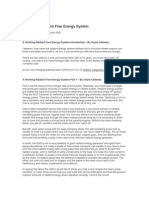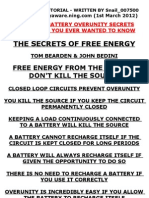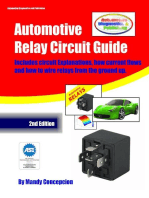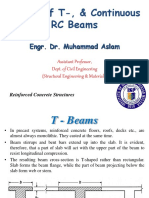0 ratings0% found this document useful (0 votes)
385 views(Free Energy) Car by Water Carplans (With Patent)
(Free Energy) Car by Water Carplans (With Patent)
Uploaded by
Bobo BoboCopyright:
© All Rights Reserved
Available Formats
Download as PDF, TXT or read online from Scribd
(Free Energy) Car by Water Carplans (With Patent)
(Free Energy) Car by Water Carplans (With Patent)
Uploaded by
Bobo Bobo0 ratings0% found this document useful (0 votes)
385 views33 pagesOriginal Title
(Free Energy)Car by Water Carplans(With Patent)
Copyright
© © All Rights Reserved
Available Formats
PDF, TXT or read online from Scribd
Share this document
Did you find this document useful?
Is this content inappropriate?
Copyright:
© All Rights Reserved
Available Formats
Download as PDF, TXT or read online from Scribd
Download as pdf or txt
0 ratings0% found this document useful (0 votes)
385 views33 pages(Free Energy) Car by Water Carplans (With Patent)
(Free Energy) Car by Water Carplans (With Patent)
Uploaded by
Bobo BoboCopyright:
© All Rights Reserved
Available Formats
Download as PDF, TXT or read online from Scribd
Download as pdf or txt
You are on page 1of 33
At a glance
Powered by AI
The document proposes plans to convert a vehicle to run on water using a system that converts water into hydrogen and oxygen gases for combustion in the engine.
The plan is to build and install a low-cost system that converts tap water into gaseous hydrogen and oxygen, which are then burned in the engine instead of gasoline.
The components needed are a plastic water tank, a control circuit, a reaction chamber, a high-pressure carburetor/fuel injection fitting, and 3 gauges. The system would plug into the existing carburetor or fuel injection system.
PRELIMINARY PLANS
TO RUN YOUR CAR ON TAP WATER!
IT ALSO WORKS ON YOUR
TRUCK / RV / MOTORCYCLE / AIRPLANE (ETC)
Will This Work?
These pl ans wer e sent t o t he Spirit of Ma'at anonymousl y, f r omsomeone who does
not want hi s or her name pr i nt ed ( f or obvi ous r easons) .
We have had t hemchecked by an exper t who bel i eves t hat t hey ar e r eal .
We al so have t al ked wi t h anot her i ndi vi dual who has pat ent ed a si mi l ar devi ce,
and we know by per sonal exper i ence t hat t he t echnol ogy i s sound.
So al t hough we cannot guar ant ee i t , we bel i eve t hese pl ans wi l l enabl e you t o
bui l d a car t hat r uns on wat er .
I f you t est i t out , t hough, do as t he wr i t er suggest s and use an ol d car t hat
doesn' t r epr esent a l oss of val ue i f you can' t make i t wor k. And l eave
ever yt hi ng i nt act so t hat you can al ways r econnect back t o gas i f you have t o.
But i f you do get i t wor ki ng, pl ease send us your exper i ence f or our r eader s.
You coul d be a nat i onal her o and hel p save our count r y and our wor l d.
We know f or cer t ai n t hat an aut omobi l e wi l l r un on wat er . So t hi s coul d be an
i nt er est i ng pr oj ect f or you mechani cal t ypes, wi t h a gr eat r ewar d of never
havi ng t o pur chase gasol i ne f or t he r est of your l i f e and hel pi ng humani t y at
t he same t i me.
Re The Need to Rustproof Your Exhaust System
I t i s possi bl e t o make a hybr i d of bot h gas and wat er ( a syst emt hat i s bei ng
t est ed now i n Mexi co) , whi ch woul d el i mi nat e t he need t o open t he head and
r emove t he exhaust syst em. J ust a t hought . I t t akes onl y a smal l amount of gas
t o keep t he syst emdr y.
The t ext sent f r omt he anonymous i ndi vi dual was edi t ed sl i ght l y f or bet t er
r eadi ng. The f ol l owi ng i s hi s/ her wor ds and dr awi ngs, whi ch has been gi ven i nt o
t he publ i c domai n.
Spirit of Maat LLC
Introduction
It is suggested you try this out to begin with on a second vehicle you own, one that you
don't need to live with everyday, until you perfect this technology.
Do-it-yourself plans allow the individual (that's you and me, folks) to make a difference.
This is the easiest and lowest-cost way to convert your car to run on (relatively) free
energy.
Now, with existing technology, anyone can stand up and make a difference by reducing
the local automotive pollution, eliminate gasoline expenses, help restore our atmosphere,
and breathe a little easier.
In putting these plans into operation, you will be making use of your entire existing system
except for the fuel tank and the catalytic converter.
The Plan
Build and install a low-cost alternative method for running your vehicle (internal
combustion engine) on tap water, using off-the-shelf components.
This is simply an efficient way to convert ordinary tap water into gaseous hydrogen and
oxygen, and then burn these vapors in the engine, instead of gasoline.
This "minisystem" runs easily from your existing battery and electrical system, and it plugs
into your carburetor with simple off-the-shelf fittings.
You will be installing a plastic water tank, a control circuit, a reaction chamber, a hi-
pressure carb/FI fitting, and 3 gauges, and then hooking into your existing carb/FI.
The simplicity comes from its being an "on-demand" system requiring no fancy storage or
plumbing. You crank the gas pedal or throttle, and you electrically create more vapor for
immediate consumption, on demand; low-high flow rate as needed, from idle to maximum
power. The only real change is that you are using tap water as fuel, instead of the
traditional petroleum-based fuel.
Given a choice, which way would you choose?
Frequently Asked Questions
Q: Does it really work ?
A: Yes; this is well-established technology dating back to stainless steel. But be sure to
follow these instructions using the proper mechanical and electrical assembly techniques,
as this plan incorporates the best qualities of several techniques.
Q: How does it qualify as "free energy"?
A: If you're paying someone for the water you use, then it is not strictly free. But the
alternative is to keep buying into expen$ive ga$oline and its resultant hydrocarbon
pollution.
Q: Is it safe?
A: Technically, it is safer than running on fossil fuel because you are no longer choking on
your own emissions (health-wise). In general, it is practically as safe as your current
gasoline arrangement. You will be installing a few simple safety devices, using current
automotive standards.
Q: What kind of performance can I expect?
A: Properly adjusted, your modified vapor-only fuel system will run cooler, and at a
modestly higher power level. The mileage performance expected from this design ranges
from 50-300 mpg (of water), depending on your adjusting skills.
Q: Can I do the modification myself?
A: Why not? If you don't have any mechanical skills, and you know someone with basic
mechanical and/or electrical skills, you can even delegate some of the construction. If you
are using a fuel-injected engine, you may have to get a mechanic's opinion. [There will
have to be an adapter inserted into the fuel-injection system, just as you would have to do
if you were going to run on propane, hydrogen, or natural gas. Ed.)
Q: What is the environmental impact that my vehicle will have?
A: It will be producing H
2
0 steam (water vapor) and unburnt O
2
(Oxygen). Hence, it will be
cleaning the environment, rather than dumping nauseous toxins into it. Plus you will be
helping to save our dwindling supply of atmospheric oxygen. Any excess vapor in the
reaction becomes either steam or oxygen. You can also expect to be receiving more than
casual interest from those around you.
Q: Isnt this really a steam engine?
A: No. Really. Exceedingly high temperature and pressure are not used. This is strictly an
internal-combustion engine (burning orthohydrogen) with residual steam in the exhaust as
a by-product.
Read This
There are a few things you should know about gasoline:
Gasoline as a fuel is not necessary; it is optional.
Gasoline versus Water
There is a lot of thermochemical energy in gasoline, but there is even more energy in
water. The DOE (Department of Energy) has quoted about 40%, so it is probably much
more than that.
Most people are unaware that "internal combustion" is defined as "a thermo-vapor
process" as in "no liquid in the reaction." Most of the gasoline in a standard internal
combustion engine is actually consumed, (cooked, and finally, broken down) in the
catalytic converter after the fuel has been not-so-burnt in the engine. Sadly, this means
that most of the fuel we use in this way is used only to cool down the combustion process,
a pollution-ridden and inefficient means of doing that.
How It Works
Exceedingly simple. Water is pumped as needed to replenish and maintain the liquid level
in the chamber. The electrodes are vibrated with a 0.5-5A electrical pulse which breaks
2(H
2
O) =>2H
2
+O
2
. When the pressure reaches say 30-60 psi, you turn the key and go.
You step on the pedal, you send more energy to the electrodes, and thus more vapor to
the cylinders; i.e. fuel vapor on demand.
You set the idle max-flow rate to get the most efficient use of power, and you're off to the
races.
In the big picture, your free energy is coming from the tap water in an open system, as the
latent energy in the water is enough to power the engine and hence drive the alternator
and whatever belt-driven accessories. And the alternator is efficient enough to run the
various electrical loads (10 - 20 amps), including the additional low current to run this
vapor reaction. No extra batteries are required.
STEP BY STEP CONSTRUCTION (Please refer to diagrams)
OVERVIEW - Here is the suggested sequence of steps:
1. Install the CHT (or EGT) gauge and measure your current operating temp range
(gasoline), for comparison.
2. Build and test the controller to verify the correct pulse output.
3. Build the reaction chamber and test it with the controller (i.e pressure out).
4. Install the tank, controller, chamber, and pressure fittings.
5. Run engine and adjust the control circuit as necessary for best performance.
6. Install the stainless steel valves and get the pistons/cylinders coated with ceramic.
7. Coat the exhaust system with ceramic without the catalytic converter (or let it rust out
and then replace the whole dang thang with stainless steel pipe sections).
YOU WILL NEED
plastic water tank with pump and level sensor.
control circuit, wiring, connectors, and epoxy.
reaction chamber with electrodes and fittings.
3/8" stainless steel flex-tubing, fittings and clamps.
carb/FI vapor-pressure fitting kit. - pressure, CHT (or EGT), & level gauges.
stainless steel valves.
copper mesh junction.
ceramic surface treatment for cylinders & pistons.
stainless steel or ceramic treated exhaust assembly.
BASIC TOOLS
drill, screwdriver and pliers
hole cutter
wire-wrap, solder-iron and clippers
DVM and oscilloscope.
REACTION CHAMBER
Construct as shown in the diagrams. Use a section of 4" PVC waste pipe with a threaded
screw-cap fitting on one end and a standard end-cap at the other. Make sure to drill-and-
epoxy or tap threads thru the PVC components for all fittings. Set and control the water
level in the chamber so that it well submerses the pipe electrodes; yet leave some
headroom to build up the hydrogen/oxygen vapor pressure. Use stainless steel wires
inside the chamber or otherwise use a protective coating; use insulated wires outside.
Ensure that the epoxy perfects the seal, or otherwise lay down a bead of water-proof
silicone that can hold pressure.
The screw fitting may require soft silicone sealant, or a gasket; its purpose is to hold
pressure and allow periodic inspection of the electrodes. No leaks, no problems. Make
sure you get a symmetric 1-5mm gap between the 2 stainless steel pipes. The referenced
literature suggests that the closer to 1mm you get, the better. You will want to get your
chamber level sensor verified before you epoxy the cap on.
Make your solder connections at the wire/electrode junctions nice, smooth, and solid; then
apply a water-proof coating, e.g. the epoxy you use for joining the pipes to the screw cap.
This epoxy must be waterproof and be capable of holding metal to plastic under pressure.
You will want to get your chamber level sensor verified before you epoxy the cap
on.
CONTROL CIRCUIT
The diagrams show a simple circuit to control and drive this mini-system. You are going to
make a 'square-pulse' signal that 'plays' the electrodes like a tuning fork; which you can
watch on an oscilloscope. The premise given by the literature is: the faster you want do go
down the road, the 'fatter' you make the pulses going into the reaction chamber. Duty
cycle will vary with the throttle in the vicinity of 90%MARK 10%SPACE (OFF/ON).
There is nothing sacred about how the pulse waveform is generated; there are many ways
to generate pulses, and the attached diagrams show a few. The diagram shows the
NE555-circuit approach from the referenced patent. The output switching transistor must
be rated for 1-5 amps @ 12VDC (in saturation).
Go with a plan that works for you or your friendly neighborhood technoid or mechanic, and
go get all the circuit elements from your local electronics store, such as Radio-Shack or
Circuits-R-Us, including the circuit board, IC sockets, and enclosure/box.
DigiKey has better selection, service, and knowledge; plus they have no minimum order.
Be sure to use a circuit board with a built-in ground plane, and to accommodate room for
mounting 2 or 3 of the gauges. Mounting the reaction chamber in the engine compartment
will require running a stub to your pressure gauge where you can watch it.
You can easily make 30-gauge wire-wrap connections between the socket pins and thru-
hole discrete components having wire leads. Also make sure to get spec sheets on any IC
you use. More details of the best circuits to use will be announced pending prototype
testing. You will want to get your chamber level sensor verified before you epoxy the
cap on.
Throttle Control
If you have a throttle position sensor, you should be able to access the signal from the
sensor itself OR from the computer connector. This signal is input to the circuit as the
primary control (i.e. throttle level =pulse width =vapor rate).
If you don't have such a signal available, you will have to rig a rotary POT (variable
resistor) to the gas linkage (i.e. coupled to something at the gas pedal or throttle cable
running to the carb or FI. If you make the attachment at the carb/FI, be sure to use a POT
that can handle the engine temp cycles. Don't use a cheezy-cheapy POT; get one rated
for long life and mechanical wear; mount it securely to something sturdy and stationary
that will not fall apart when you step on the gas.
Control Range. The full throttle RANGE (idle-max) MUST control the vapor rate, i.e. pulse-
width (duty). The resistor values at the throttle signal must allow the throttle signal voltage,
say 1-4 Volt swing, to drive the VAPOR RATE. You will be using this voltage swing to
generate a 10% ON 'square' pulse. The patent implies using a 'resonant' pulse in the 10-
250 KHz frequency range; but it is not explicitly stated so.
In this circuit, you will simply tune to whatever frequency makes the most efficient vapor
conversion. You will have to get into the specs for each IC you use, to insure you connect
the right pins to the right wires, to control the frequency and pulse width. You can use
spare sockets to try out different discrete component values. J ust keep the ones that are
spec-compatible in the circuit, and get the job done.
You crank up the throttle signal and put more electrical energy (fatter pulses) into the
electrodes; verify you can get 10% duty on the scope (2 - 100 usec on the horizontal time-
base). Your averaging DVM will display the 90%-10% DC voltage across the output
transistor (Vce or Vds or Output to Ground). Set and connect DVM in the supply current
and measure .5 - 5 amps, without blowing the DVM fuse. Now verify that you got
everything you wanted.
Verify your wiring connections using your DVM as a continuity detector. Check your wiring
1 at a time and yellow line your final schematic as you go. You can best use board-mount
miniature POTs for anything you want to set-and-forget. The LEDs are there to give you a
quick visual check of normal vs abnormal operation of your new creation. You will want
to get your chamber level sensor verified before you epoxy the cap on.
CARB/FI CONNECTION
The diagram also shows that fittings are required to the carb/FI l. There are ready-made
kits (such as by Impco) available for making your pressure fittings to the carburetor or fuel-
injector as the case may be. You will necessarily be sealing the built-in vents and making
a 1-way air-intake.
The copper mesh comprises the inadvertent backfire' protection for the reaction chamber.
Make sure that all vapor/duct junctions are air-tight and holding full pressure without
leakage. Your new 'system' is considered successful and properly adjusted when you get
the full power range at lower temp and minimum vapor flow without blowing the pressure
safety valve.
CHT (or EGT)
Monitor your engine temp with the CHT (cylinder head temp) or EGT (exhaust gas temp)
instead of your original engine temp indicator (if any). Your existing gauge is too slow for
this application and will not warn you against overheating until after you have burnt
something. Make sure that your engine runs no hotter than in the gasoline
arrangement. VDO makes a CHT gauge with a platinum sensor that fits under your spark
plug against the cylinder head (make sure it is really clean before you re-install your
spark plug (as this is also an electrical ground).
ENGINE/EXHAUST TREATMENT
Get the valves replaced with stainless steel ones and get the pistons/cylinders ceramic-
treated ASAP when you have successfully converted and run your new creation. Do not
delay as these items will rust, either by sheer use or by neglect (i.e. letting it sit). You
could make max use of your current exhaust system by using it with your new deal until it
rusts through, then have your mechanic or welder friend to fit a stainless steel exhaust
pipe (no catalytic converter is required). But it could be easier and cheaper to send your
existing exhaust system out for the ceramic treatment, and then simply re-attach it to the
exhaust ports.
GENERAL
1. Do not discard or remove any of the old gasoline setup components, e.g. tank, carb/FI,
catalytic converter, unless necessary. Better to always leave an easy way to revert
back to something that at least runs, just in case. Some people are leaving their
gasoline setup completely intact, and switching back and forth at will, just to have a
backup plan.
2. Set your throttle circuit so that you get minimum vapor flow at idle, and maximum
vapor flow at full power without blowing the pressure relief valve. In this way, you
control how 'lean' your mixture is by the strength of the pulse (i.e. fatness at the
optimum pulse frequency).
3. If you just don't get enough power (at any throttle setting), it means that you need to (1)
change the pulse frequency, (2) change the gap between the electrodes, (3) change
the size (bigger) electrodes, or (4) make a higher output pulse voltage (last resort).
Always use an output transistor, such as a MOSFET, that is rated for the voltage and
current you need to get the job done. OK so you might have to play around with it
some. Isn't that where all the Fun is anyhow?
4. If you get any engine knock our loud combustions (not compensated by adjusting the
timing), it means that you need to install an additional coil in the chamber, and drive
the coil with an additional pulse signal (about 19 Hz on the .1sec time base (see
diagram). Here, you will be slowing down the burn rate just enough so that the vapors
burn thru out the power stroke of the piston. Be sure to include a board-mount POT to
set the correct strength of this 2nd pulse signal into the coil. This is a stainless steel
coil of about 1500 turns (thin wire) that you can arrange like a donut around the center
pipe (but NOT touching either electrode), directly over the circular 1-5mm gap. You
want no knocking at any power/throttle setting; smooth power only, but also no
excess hydrogen leftover from the combustion.
5. Build the canister(s) as tall as you can without compromising your ability to mount
them conveniently near the dash panel, or in the engine compartment, as the case
may be. This way, you can always make the electrodes bigger, if necessary without
undue hardship. Remember that anything in the engine compartment should be
mounted in a bullet-proof, vibration and temperature tolerant fashion.
6. If you have to drill a thru-hole for wiring or plumbing thru metal, make sure to also
install a grommet for protection against chafing. Always watch your chamber pressure
range from IDLE (15-25 psi) - FULL POWER (30-60 psi). Set your safety-pressure
relief-valve to 75 psi and make sure it's rated for much higher.
7. Shut OFF the power switch and pull over if there is any malfunction of the
system. Your engine will last longest when it still develops FULL POWER+at some
minimum temperature that we are sure you can find, by leaning back the Royal Vapor
Flow and/or by making use of the water-vapor cooling technique (see diagram). Keep
good mpg performance records, and periodic maintenance/inspection. Keep it clean;
save some money; clean the air; heal the planet; happy motoring; tell a friend; enjoy
your freedom and self-empowerment.
8. There lacks documented material for perfecting this vapor system thru a fuel injector;
there may be some details you will discover on your own as working prototypes
progress. For example, you may be restricted to inject the hydrogen/oxygen vapor
without any water vapor, as it may rust the injectors. If engine temp and CHT is a
problem, then you will want to re-think your plan, e.g. ceramic-coating the injectors.
There is always replacing the FI system with a Carb.
9. If you install the water-vapor system (for lower operating temp/stress), you will want to
lean the mixture (vapor/air) for minimum vapor flow rate to achieve any given throttle
position (idle - max). Make sure that you get a minimum flow for IDLE and a modestly
sufficient flow for MAX, that does the cooling job without killing the combustion.
10. If you cannot find stainless steel pipe combinations that yield the 1-5mm gap, you can
always regress back to alternating plates of +/- electrodes.
11. If you are concerned about the water freezing in your system, you can (a) add some
98% isopropyl alcohol and re-adjust the pulse frequency accordingly; or (b) install
some electric heating coils.
12. Do not let ANYONE ever compromise your dream, your freedom, your
independence or your truth.
REFERENCES
Stephen Chambers 'Apparatus for Producing Orthohydrogen and/or
Parahydrogen' US Patent 6126794, uspto.gov
Stanley Meyer 'Method for the Production of a Fuel Gas' US Patent 4936961,
uspto.gov
Creative Science & Research, 'Fuel From Water', fuelless.com
Carl Cella A Water-Fuelled Car Nexus Magazine Oct-Nov 1996
Peter Lindemann Where in the World is All the Free Energy, free-energy.cc
George Wiseman The Gas-Saver and HyCO Series eagle-research.com
C. Michael Holler The Dromedary Newsletter and SuperCarb Techniques
Stephen Chambers Prototype Vapor Fuel System xogen.com
COMMON LAW COPYRIGHT #285714: All rights to the use and duplication of these
plans are hereby reserved for the People, in their efforts to heal and restore the
environment. Dare to express your uniqueness and environmental ideals. This technology
is an exercise in responsible self-determination.
DISCLAIMER: The Spirit of Ma'at LLC and the Spirit of Ma'at ezine and the author of this
document assumes no liability for the use or misuse of this information; which is made
available as public-domain information and free of charge, for the purposes of education,
ecology, health, well-being, freedom, liberty, and pursuit of happiness.
You might also like
- The Magnet Motor: Making Free Energy Yourself Edition 2019From EverandThe Magnet Motor: Making Free Energy Yourself Edition 2019Rating: 4 out of 5 stars4/5 (6)
- 362-RCm2 FuellessEngineM2 Plans Part1Document15 pages362-RCm2 FuellessEngineM2 Plans Part1Leonardo Eladio Vergara100% (3)
- Free Energy SurpriseDocument21 pagesFree Energy SurpriseJeanJones100% (3)
- Petkov Document CircutisDocument470 pagesPetkov Document CircutisJumpman Outlet100% (2)
- Quantum Energy Generator - Free Energy Device BlueprintsDocument35 pagesQuantum Energy Generator - Free Energy Device Blueprintsenerchi111185% (20)
- 2kW Free Energy Device - Don SmithDocument5 pages2kW Free Energy Device - Don SmithJake Mitchell80% (30)
- The Fuelless Engine M2 or SP500: Anti-Pirate Customer ID #Document15 pagesThe Fuelless Engine M2 or SP500: Anti-Pirate Customer ID #Leonardo Eladio Vergara100% (10)
- Resonance Energy by BelkiredDocument28 pagesResonance Energy by BelkiredAndres SiposNo ratings yet
- Quick Guide On The FDR NanoDocument13 pagesQuick Guide On The FDR NanoHanin Allouche100% (2)
- A Book in Every Home Containing Three Subjects: Ed’s Sweet Sixteen, Domestic and Political ViewsFrom EverandA Book in Every Home Containing Three Subjects: Ed’s Sweet Sixteen, Domestic and Political ViewsRating: 5 out of 5 stars5/5 (2)
- Secret High Power Free Energy CircuitDocument23 pagesSecret High Power Free Energy Circuitvladcoinstal100% (4)
- William Alek - How To Build Solid-State Electrical Over-Unity DevicesDocument29 pagesWilliam Alek - How To Build Solid-State Electrical Over-Unity Devicesairedale terror90% (10)
- Self Running Free Energy Device Muller Motor Generator Romerouk Version1 1Document25 pagesSelf Running Free Energy Device Muller Motor Generator Romerouk Version1 1Hydrostatic0013100% (5)
- Free Energy TransformersDocument6 pagesFree Energy TransformerstipescuNo ratings yet
- Tesla - SekretyDocument82 pagesTesla - SekretyKWojtek80% (5)
- Over-Unity Motor Doc - 1Document26 pagesOver-Unity Motor Doc - 1falcontrust100% (2)
- Board Questions CriminalisticsDocument14 pagesBoard Questions CriminalisticsAries Gallandez100% (1)
- FREE ENERGY Tesla Secrets For EverybodyDocument58 pagesFREE ENERGY Tesla Secrets For Everybodyxavier102772100% (3)
- Swiss Testakica Free Energy DeviceDocument9 pagesSwiss Testakica Free Energy DeviceДејан Павловић75% (4)
- The Free Energy TransformerDocument12 pagesThe Free Energy Transformer1234567890sc73% (11)
- 10 Free Energy TechnologiesDocument65 pages10 Free Energy TechnologiesKWojtek92% (24)
- Making An Electr EtDocument2 pagesMaking An Electr EtCarlos Marighella100% (1)
- Free Energy GeneratorsDocument3 pagesFree Energy GeneratorsYogesh25% (4)
- Hubbard Coil. VAZNODocument12 pagesHubbard Coil. VAZNOTomislav JovanovicNo ratings yet
- The Overunity and FreeEnergy CatalogDocument72 pagesThe Overunity and FreeEnergy Catalogiaraaipicat71% (14)
- A Working Radiant Free Energy SystemDocument7 pagesA Working Radiant Free Energy Systemmysticdream88% (8)
- Quantum Energy Generator (QEG) - REVISED Manual Edition (March 2015)Document75 pagesQuantum Energy Generator (QEG) - REVISED Manual Edition (March 2015)FreeEnergyWorld100% (4)
- 362-RCm2 FuellessEngineM2 Plans Part5 PDFDocument15 pages362-RCm2 FuellessEngineM2 Plans Part5 PDFLeonardo Eladio Vergara100% (2)
- The Secrets of Building Lead Acid Battery Free Energy Devices FINALDocument13 pagesThe Secrets of Building Lead Acid Battery Free Energy Devices FINALhhelp1225591% (11)
- How To Build A Magrav Power Unit FREE Energy DeviceDocument11 pagesHow To Build A Magrav Power Unit FREE Energy DeviceFreeEnergyWorld82% (11)
- 362-RCm2 FuellessEngineM2 Plans Part8Document15 pages362-RCm2 FuellessEngineM2 Plans Part8Leonardo Eladio Vergara67% (3)
- Build A Free Energy Power Transformer For IncomeDocument9 pagesBuild A Free Energy Power Transformer For IncomeMatt Fombong100% (2)
- Ravi CellDocument45 pagesRavi Cellapi-3725726100% (1)
- Stanley Meyer Big Bobbin Builders Guide 2019 v1: Very Rare Guide for How to Assemble Water Fueled injector tri-filar bobbinFrom EverandStanley Meyer Big Bobbin Builders Guide 2019 v1: Very Rare Guide for How to Assemble Water Fueled injector tri-filar bobbinNo ratings yet
- Induction Coils - How To Make, Use, And Repair Them: Including Ruhmkorff, Tesla, And Medical Coils, Roentgen, Radiography, Wireless Telegraphy, And Practical Information On Primary And Secodary BatteryFrom EverandInduction Coils - How To Make, Use, And Repair Them: Including Ruhmkorff, Tesla, And Medical Coils, Roentgen, Radiography, Wireless Telegraphy, And Practical Information On Primary And Secodary BatteryRating: 5 out of 5 stars5/5 (2)
- Car PlansDocument14 pagesCar PlansclassifiedabovetopsecretNo ratings yet
- Car PlansDocument11 pagesCar Planslaurlos100% (2)
- Water FuelDocument15 pagesWater FuelThang Tong100% (1)
- Didactico - Water Car Engine Plans Manual - Hydrogen Fuel - Use Tap Water (En Inglés)Document14 pagesDidactico - Water Car Engine Plans Manual - Hydrogen Fuel - Use Tap Water (En Inglés)Manuel BolonNo ratings yet
- Waterfuel: Introduction & OverviewDocument27 pagesWaterfuel: Introduction & Overviewtbang458928No ratings yet
- Fuel From Water E-BookDocument20 pagesFuel From Water E-Bookperolos100% (2)
- How To Make HHO and PWMDocument20 pagesHow To Make HHO and PWMWilly Ortega100% (11)
- Carl Cella Water CarDocument8 pagesCarl Cella Water CarRuddyMartiniNo ratings yet
- Automotive Equipment Usage and Repair StrategiesFrom EverandAutomotive Equipment Usage and Repair StrategiesRating: 5 out of 5 stars5/5 (1)
- p0741 ThesisDocument4 pagesp0741 Thesiskualxkiig100% (1)
- KE Jetronic Diagnosis Eha, Pot Testing Etc.Document7 pagesKE Jetronic Diagnosis Eha, Pot Testing Etc.Csaba László100% (3)
- Polaris Ignition SystemDocument3 pagesPolaris Ignition Systemluvmaine2No ratings yet
- A Hydrogen Generator You Can BuildDocument19 pagesA Hydrogen Generator You Can BuildTri Yuniarto0% (1)
- Water Fueled CarDocument10 pagesWater Fueled CardanevideNo ratings yet
- Counterp v2 I2 1998Document4 pagesCounterp v2 I2 1998papipapiiNo ratings yet
- Chapter 10: Automotive SystemsDocument71 pagesChapter 10: Automotive Systemsgabriela69sNo ratings yet
- Chapter 10Document75 pagesChapter 10Aleksa Nataša RančićNo ratings yet
- WGS101 Analysis 6Document5 pagesWGS101 Analysis 6Mico DichosoNo ratings yet
- Hho Dry Cell 21plates InfoDocument8 pagesHho Dry Cell 21plates Infoz987456321100% (1)
- 3 Глава ДонорDocument8 pages3 Глава ДонорdesuyaNo ratings yet
- Automatic Transmission (At) Flush Procedure - Nissandiesel ForumsDocument8 pagesAutomatic Transmission (At) Flush Procedure - Nissandiesel ForumsJohnnyLarsonNo ratings yet
- Untitled DocumentDocument2 pagesUntitled DocumentJoel Stanley TylerNo ratings yet
- Literature Review On Fuelless GeneratorDocument8 pagesLiterature Review On Fuelless Generatorafdtywgdu67% (3)
- PSV - Second Term of API FormulaDocument5 pagesPSV - Second Term of API FormuladebjpaulNo ratings yet
- EDC Pump Testing ProceduresDocument8 pagesEDC Pump Testing ProceduresCadet Raparivo100% (7)
- Salted Egg Cleanser Machine ManuscriptDocument86 pagesSalted Egg Cleanser Machine ManuscriptJoey MalabananNo ratings yet
- A Computational Model For Suspended Large Rigid Bodies in 3D Unsteady Viscous Flows XiaoDocument32 pagesA Computational Model For Suspended Large Rigid Bodies in 3D Unsteady Viscous Flows XiaowatersakanaNo ratings yet
- Issues With Cement Bond and Cement Evaluation Logs-Case StudiesDocument11 pagesIssues With Cement Bond and Cement Evaluation Logs-Case StudiesAnkit SharmaNo ratings yet
- Design of Continuous RC BeamsDocument14 pagesDesign of Continuous RC Beamsengineer khanNo ratings yet
- Ancient Chinese Imperial Tombs Study - Qin Shi Huang Mausoleum Archeological Research and Protective Exploratory Rescue Passive Mining (Fang Ruida) Chinese simplified version Traditional Chinese version English version French versionDocument22 pagesAncient Chinese Imperial Tombs Study - Qin Shi Huang Mausoleum Archeological Research and Protective Exploratory Rescue Passive Mining (Fang Ruida) Chinese simplified version Traditional Chinese version English version French versionAlvisNo ratings yet
- Type KDocument4 pagesType KAmal ..No ratings yet
- Experimental Study On Manufacturing Metal Bellows FormingDocument5 pagesExperimental Study On Manufacturing Metal Bellows FormingNayri AkbugaNo ratings yet
- d1) 2DOF (Rev1)Document44 pagesd1) 2DOF (Rev1)chocsoftwareNo ratings yet
- Soil CompactionDocument24 pagesSoil Compactionmark galangNo ratings yet
- Model Predictive Control in LabVIEWDocument22 pagesModel Predictive Control in LabVIEWBrankko Jhonathan Torres SaavedraNo ratings yet
- Ratios3 PDFDocument7 pagesRatios3 PDFPavel Remmy100% (1)
- 3 Polyflow - 12.1 Polyflow ExampleDocument36 pages3 Polyflow - 12.1 Polyflow Examplewoongs73No ratings yet
- For You to Do 1. In an area free of obstacles, stretch out a Slinky® so the turns are a few Centimeters apart. Mark the positions of the end of the Slinky by sticking pieces of Tape on the floor. Measure the distance between the pieces of tape. a) Record the distance between the pieces of tape in your log. 2. With the Slinky stretched out to the tape, grab the spring near one end, as Shown in the drawing, and pull sideways 20 cm and back. To move it correctly,Document4 pagesFor You to Do 1. In an area free of obstacles, stretch out a Slinky® so the turns are a few Centimeters apart. Mark the positions of the end of the Slinky by sticking pieces of Tape on the floor. Measure the distance between the pieces of tape. a) Record the distance between the pieces of tape in your log. 2. With the Slinky stretched out to the tape, grab the spring near one end, as Shown in the drawing, and pull sideways 20 cm and back. To move it correctly,api-26084273No ratings yet
- OscillatorsDocument16 pagesOscillatorsAbbas Bagherifar100% (7)
- Universal Current SensorDocument12 pagesUniversal Current SensorBhargav MushiniNo ratings yet
- ANSYS Mechanical APDL Multibody Analysis Guide 18.2Document72 pagesANSYS Mechanical APDL Multibody Analysis Guide 18.2Panda HeroNo ratings yet
- Adhesion TestingDocument4 pagesAdhesion Testingmehul2011No ratings yet
- Common Engineering Unit ConversionsDocument3 pagesCommon Engineering Unit Conversionsravandkumar100% (1)
- Guardiola - Design of Timber Beams in Bending According To DB SE Madera (CTE)Document10 pagesGuardiola - Design of Timber Beams in Bending According To DB SE Madera (CTE)Aashir AshfaqNo ratings yet
- Energy Storage in Ceramic DielectricsDocument6 pagesEnergy Storage in Ceramic DielectricsJJ SerraltaNo ratings yet
- Datasheet Stratos PARA 1-8Document10 pagesDatasheet Stratos PARA 1-8Ja SixNo ratings yet
- Creep Characterization of Amorphous Sio in The Transmission Electron Microscope Using Digital Image Correlation and Finite Element AnalysisDocument16 pagesCreep Characterization of Amorphous Sio in The Transmission Electron Microscope Using Digital Image Correlation and Finite Element AnalysisTRA ANH KHOA NGUYENNo ratings yet
- Gyroscope PhysicsDocument24 pagesGyroscope PhysicssrrisbudNo ratings yet
- Motion ProfilesDocument7 pagesMotion ProfilesArkady90No ratings yet
- Lorenzana Assignment 2 Machine Design 1Document7 pagesLorenzana Assignment 2 Machine Design 1Lister NambatacNo ratings yet
- AN17821ADocument9 pagesAN17821ARuben Xavier RodriguezNo ratings yet
- The God Concept of Aristotle PDFDocument13 pagesThe God Concept of Aristotle PDFjopinon.ocarmNo ratings yet
- Feynman PaperDocument4 pagesFeynman PaperJun Rey LincunaNo ratings yet

























































































